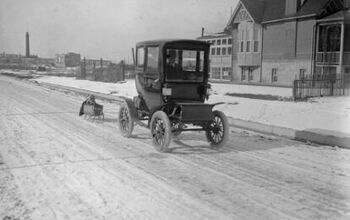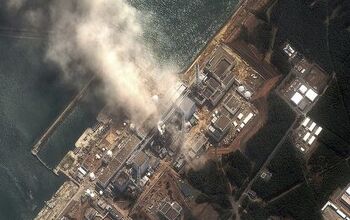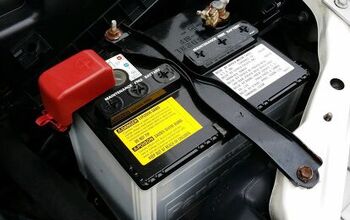Developing the Electric Car: Who's In Charge?
On January 24, President Bush issued an executive order. All federal agencies with 20 or more vehicles in their fleet will now use plug-in hybrid vehicles– “when PIH vehicles are commercially available at a cost reasonably comparable, on the basis of life-cycle cost, to non-PIH vehicles." Cool. So, ah, where are these government buggies and when will we see some sporting a U.S. Fish and Wildlife Service crest on the doors? This, my friends, is what’s called a “faith based initiative.”
Nobody in America currently sells a plug-in hybrid. Some seriously brave hackers have converted a Toyota Prius or two. And that’s about it. General Motors wooed a covey of press at the Detroit auto show with the Volt, their collective dream of a plug-in hybrid electric vehicle. The spinmeisters say it may be on the street in three years, if it’s able to fly General Lee style over a fat, flaming obstacle: batteries.
Lithium-ion batteries are currently our best electricity storage devices. They serve the lap-top and cell phone world nicely– at least for the moment. Compared to other batteries, they’re fairly light. On the downside, they catch fire if their insides are exposed to oxygen; not a great feature in a car. But it’s not an impossible situation. The all-electric Tesla Roadster uses an array of 6,831 lithium-ion cells, deploying a number a safety devices to keep it from becoming Tesla toaster.
The other downside: weight. While the two-passenger ultra-light Tesla can get away with schlepping a bunch of batteries, a mid-size sedan, pick-up truck stuffed with a bed full of peat moss or an SUV full of Boy Scouts, sleeping bags, tents and scarves are going to struggle just to get rolling.
General Motors hopes new, lighter batteries will be developed before people start asking when they can pick up their Volts. Notice the qualifier. The General isn’t committing to a timeline for the Volt. What they and their Detroit brethren really, really want, what the battery world probably needs, is a Manhattan Project-style initiative to give the domestic battery community a… um… charge.
The League of Beleaguered Gentlemen may actually get their wish. In the President’s 2007 State of the Union address he said, “We need to press on with battery research for plug-in and hybrid vehicles…” Not exactly a promise of billions, brains or tax-breaks, but it’s nice to get a nod. China, Korea and Japan have national lithium ion battery development programs, putting them each a half a lap ahead. But, the US has lithium reserves in Nevada, so it’s not out of the race. And the lithium race is not the only game in town.
When it comes to who really killed the electric car, the culprits are cost, weight, safety and power limits. Scientists have been looking for a better battery since Edison. More than a few think they’re almost there.
Former Air Force major Ross Dueber used to design batteries for the Strategic Defense Initiative. After retiring from government service, he didn’t take any confidential tax payer research to start Zinc Matrix. Dueber’s dudes are developing energy storage systems based on zinc (duh) rather than lithium, mostly because of that annoying flame out problem. Cost and weight will have to wait. At the moment, zinc offers no advantages there.
Europositron of Finland is working on nano technology they hope will lead to the production of rechargeable aluminum batteries. The prototypes are safe, fully recyclable and boast 20 times more capacity than current batteries. To put that in perspective, a pre-crushed GM EV1 with Europositron tech would have extended its range from 80 miles between charges to almost 600. Aluminum batteries are still at least two years from market.
The vanadium redox flow battery is the brainchild of Professor Maria Skylass-Kazacos (and team) at the University of New South Wales, Australia. Cheap, environmentally tolerable, vrf’s can be refueled in minutes, mechanically. The vanadium redox battery stores energy in a liquid electrolyte solution. The batteries can be charged by pumping in new goo, just like gas at the old fillin’ station.
A UK company called RE-Fuel is working on vehicles using vanadium batteries. Their 50 mile range leaves the comnpany concentrating on urban delivery trucks, shuttle buses, airport tenders– the kind of worker-bees that don’t venture far from the hive.
In the end, it all comes down to physics. We use a lot of gasoline because it’s a damn fine way to store energy. The need for new batteries is clear, though. You can tell because a Presidential administration made of ex-oil men says it’s time to look for alternatives. This year’s class of batteries gets by with barely a passing grade and the under classes coming up don’t look much better. So, a little advice for the next generation: stay awake in Chemistry.
More by Michael Martineck
Latest Car Reviews
Read moreLatest Product Reviews
Read moreRecent Comments
- Lou_BC Well, I'd be impressed if this was in a ZR2. LOL
- Lou_BC This is my shocked face 😲 Hope formatting doesn't fook this up LOL
- Lou_BC Junior? Would that be a Beta Romeo?
- Lou_BC Gotta fix that formatting problem. What a pile of bullsh!t. Are longer posts costing TTAC money? FOOK
- Lou_BC 1.Honda: 6,334,825 vehicles potentially affected2.Ford: 6,152,6143.Kia America: 3,110,4474.Chrysler: 2,732,3985.General Motors: 2,021,0336.Nissan North America: 1,804,4437.Mercedes-Benz USA: 478,1738.Volkswagen Group of America: 453,7639.BMW of North America: 340,24910.Daimler Trucks North America: 261,959


































Comments
Join the conversation
HEY... Here's a crazy idea. What about using an ICE and generator to power electric motor(s) to propel a car and bolster the range of the batteries for long-range driving? Got news for ya. It's not only not a crazy idea, subtract the batteries and you have a formula proven in the Diesel-Electric Locomotive. These locomotives have not only proven their design, they are among the most efficient machines for moving mass on Earth. Battery developments that will redefine electric vehicle capability are not far in the future at all, and by completely re-thinking the automobile's propulsion (as is happening, do some research) all of todays vehicles including all current "Rube Goldberg" hybrids will be exposed for what they really are: EXTREMELY inefficient.
Hey! how about turning to a group of engineers to answer the question. Do electric cars save the country energy (BTU's)? Let them do a ‘life cycle’ energy balance of gasoline verses electric. My 'gut feel' as an chemical engineer is that its much like the Ethanol debacle. The impact on imported oil and consumer cost, if positive, is insignificant. We may have to go overseas to find a group that’s competent and unbiased.